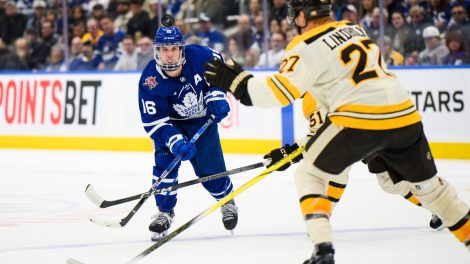On Jan. 21 the Toronto Maple Leafs announced that Dave Keon would be added to Legends Row outside the Air Canada, ending a long estrangement with the franchise.
If you were to look at only the record books, it would jump out at you. It wouldn’t be the fact that Dave Keon won the Conn Smythe Trophy when the Toronto Maple Leafs last won the Stanley Cup.
No, what would grab your attention is Keon’s post-season statistics that year: three goals and eight points in 12 games. That’s a far cry from the numbers that the likes of Wayne Gretzky, Mario Lemieux and other stars would rack up down the line. But it wasn’t simply a measure of the low-scoring times. Two years before, Jean Béliveau won playoff MVP honours with eight goals and 16 points in 13 games. Based on the numbers, Keon looked like a contributor to a championship, but not the catalyst, not the indispensable piece.
None of his teammates, however, would have argued against the award going to Keon. You had to go to the players’ households to find a dissenting voice. “My mother thought I was the most valuable player,” says Jim Pappin, who had seven goals and 15 points to lead the Leafs in scoring that spring.
Mrs. Pappin’s protests did not generate a public hue and cry, however. Keon wasn’t just the Leafs’ leading scorer during the year and their best player in victories over regular-season champions Chicago in the semifinals and Montreal in the Final. He was the key player for Leafs teams that won four Stanley Cups during the ’60s, their best player night in, night out, in all three zones, especially forechecking and disrupting defencemen. “Keon played the game the way it should be played,” says Harry Neale, who first met the centre in Toronto’s junior ranks. “He was arguably the best skater in the league. He did all the little things right. Dave could be the best player on the ice and the key to winning even in games he didn’t score.”
By some measures, the 1966–67 season, Keon’s seventh in the league, was not his best. It was the first time he had not surpassed the 20-goal mark. Still, he led the Maple Leafs in scoring with 19 goals and 52 points in 66 games. And that season was far from the team’s best. “We were going really poorly for a stretch that winter, but then [coach] Punch Imlach got sick and King Clancy took over behind the bench,” Keon says in a rare interview. “The pressure came off for a bit and we could see things a little more clearly. We were an older team, for sure, and we knew what we could do and even more what we had to do. It was going to be a grind. We weren’t a great team, but we were a very good team once the playoffs started.”
And it was Keon who led them. What was true of the Leafs’ rise that season was also true of their great run in the ’60s, when they vied with the Montreal Canadiens for supremacy in the NHL.
Dave Keon was born in Noranda, Que., in 1940, the eldest of six children. His father, also named Dave, was a miner and his mother, Laura, was a schoolteacher. In that era, the Canadiens had their run of the best prospects in the province but they had no claim on Keon. And for several seasons, the Leafs didn’t either. “Detroit signed me when I was 12 years old, and I remained [the Wings’] property until age 15,” Keon says. “At that point, though, I was an underage midget player, and I moved to a juvenile team that wasn’t sponsored by an NHL club.”
Vince Thompson, a Leafs scout who had worked with Keon on developing his game, reported back to Toronto about two prospects worth pursuing on the Noranda Lions. Toronto effectively snapped up the team so they could get Keon. Once Detroit’s rights to Keon were voided, Toronto had the inside track. Says Keon: “That season, the Leafs became the sponsor of the team and they got my rights and my friend’s, Jacques Caron. The next year, Jacques and I came to Toronto. He went to the Marlies and I went to the St. Mike’s Majors.”
Keon had never been to Toronto before he landed at the St. Michael’s College boarding school. “Really, I had never been away from home at all, and I don’t know if my parents would have agreed to it if it hadn’t been with the school,” he says. “It turned out that St. Mike’s was the really key part of my development. The biggest influences I ever had in hockey were with the Majors: Father David Bauer and Bob Goldham.”
Father Bauer, the Majors’ coach, delivered what Keon considers the toughest and ultimately most important lesson in his career. “Father Bauer told me that if I could score three goals a game, I didn’t have to worry about what happened at the other end of the ice or how I played without the puck,” Keon says of the work ethic instilled in him at St. Mike’s. “It sounds easy to understand now but it really took two years for me to accept it.”
The Majors and the Marlies were Toronto’s junior pipeline, and Keon played with and against dozens of future pros. But even though he soon established himself as St. Michael’s chief scoring threat, he didn’t give any real thought to eventually making the grade with the NHL club. “I remember going to my first Leafs game at the Gardens,” he says. “I remember being awed by the size of the building and the crowd and thinking, ‘This isn’t accessible.’ I thought that even though after that game I went down and talked to Tod Sloan, my cousin who played for the Leafs.”
By the time Keon wrapped up his junior career with the Majors, he was less awestruck. “We played our home games at the Gardens and practised there, so it started to feel a little more like home,” he says.
But even when he reported to his first training camp with the big club, the 20-year-old felt like a face in a crowd, a long shot to get a look with maybe two spots open on the roster. “There were 90 players there, and two years before, the team had been to the Stanley Cup Final,” he says. “They say that a little guy has to prove he can play and a big guy has to prove he can’t—well I was just five-foot-nine and 160 lb., one of the smallest in the camp. I just went in thinking that all I can do is do my best.”
Keon’s best was good enough to make the team, and with 21 goals by season’s end, win the Calder Trophy. “I was lucky to know a bunch of players who had played at St. Mike’s, like Frank Mahovlich, Dick Duff and Bert Olmstead,” he says. “I knew other guys like Bob Nevin and Carl Brewer from when they played with the Marlies. They really helped me along.”
With 20 minutes to go in his second season, Keon was standing at the foot of the steps up to the ice at Chicago Stadium. Game seven of the Cup Final between the Black Hawks and the Maple Leafs was scoreless. “I remember thinking that if Chicago scored, I didn’t want to be on the ice for it,” he says. “They did, and I was. We caught a break, though. The fans threw stuff on the ice and the game was held up for six or seven minutes. We were able to settle down and come back for the win. It was just one period, but I learned how bad it felt if you lost it and how great it was to win it all. You think of winning the Stanley Cup when you’re a kid, and here I thought we were going to win it every season.”
The Leafs did win it the following two springs, and Keon calls the 1963 Cup-winner team “the best I ever played on and the best in the history of the team.” He believes the top two lines, top two blueline pairings and the goaltender from ’63 should make Sportsnet magazine’s Greatest Maple Leafs of All Time. “That was the one Toronto team [in the modern era] to win the regular season and the Cup, and those players were never better,” he says. “We put it together, everybody playing as a team, and if someone got hurt, whoever came in for him did the job. We were never that good again.”
The ’63 roster had the quality, but the ’67 team had something even rarer: magic. It has remained, not only because of the Cup drought, the Toronto Cup winner that is remembered most fondly. “In part it was because it was the rivalry between the two teams and the last season of the Original Six, but there was something bigger than that,” Keon says. “We beat a great team. If the Canadiens beat us, they would have won five straight Stanley Cups, and everybody would talk about that team the same way they talk about Montreal with the Rocket in the ’50s, and the ’70s team that had the great run.”
The way history has often been written (or miswritten) in the four decades since, Keon’s major contribution to Toronto’s victory was shutting down Jean Béliveau. Not so, he says. “We played Bob Pulford and Red Kelly against Béliveau,” Keon says. “Bélievau was too big for me. I was matched up most of the time with Henri Richard.”
The “Pocket Rocket” wasn’t just Keon’s rival or nemesis. He was also a player in the same mould. “Henri and Dave were the fastest players in the league and great competitors at both ends of the ice,” says Neale. “Henri was every bit the player that Maurice [Richard] was—at least as effective and important to winning. Henri didn’t stand out or get the attention because of his personality. He didn’t want it, and Dave was exactly the same way. People who knew the game understood just what he meant to the teams he played on, but maybe not the public as much.”
Keon made two Second All-Star Teams in his career and won the Lady Byng Trophy twice. Others have more individual honours, but few beat out the talent that Keon had, Béliveau and Henri Richard included. Still, nothing better captures the quality of his game and his importance to the team than a trophy named after the legendary owner of the Maple Leafs, one featuring a silver-cast likeness of the arena where he saw his first NHL action and learned to play the game.









